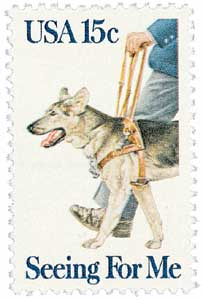
# 4604-07 - 2012 65c Dogs at Work
U.S. #4604-07
2012 65¢ Dogs at Work
Strip of 4
Issue Date: January 20, 2012
City: Merrifield, VA
Quantity: 80,000,000
Printed By: Avery Dennison
Printing Method: Photogravure
Perforations: Die Cut 10 ¾
Color: Multicolored
A well-trained working dog can often mean independence, comfort, and a second chance at life to those it helps. A combination of intelligence, endurance, and obedience is needed for canines that spend their lives serving humans. Through proper selection and intense training, dogs can be taught to aid people in many ways.
Guide dogs for visually impaired people must be friendly and comfortable with new situations. They memorize the routes to familiar destinations and can lead the way with a simple command. The dogs’ confidence allows them to travel to new places.
When a non-judgemental ear and comforting touch are needed, a therapy dog can fit the bill. Whether in times of disaster or a regularly scheduled visit, an affectionate, patient dog reduces anxiety and offers emotional support.
Using their keen sense of smell, security dogs track down criminals or hidden substances. At border crossings and stadiums, canines save time and money with their quick screening ability.
Speed is essential when someone is lost. A search and rescue dog must have agility to move over unstable surfaces to find a victim promptly.
Humans can count on dogs to be faithful guides, companions, or protectors.
The Seeing Eye
The seeing eye dog movement began in Europe in the 1920s. At that time, American Dorothy Harrison Eustis was living in Switzerland and set up a breeding and training facility for German shepherds. Working with a trainer and geneticist Elliot S. Jack Humphrey, she used a scientific method to train police dogs to be intelligent and responsible.
After World War I, many German soldiers returned home blinded or visually impaired. This led to the creation of experimental schools that taught dogs helpful skills. Eustis was impressed by these schools and wrote an article about them called “The Seeing Eye” for the November 5, 1927 issue of The Saturday Evening Post.
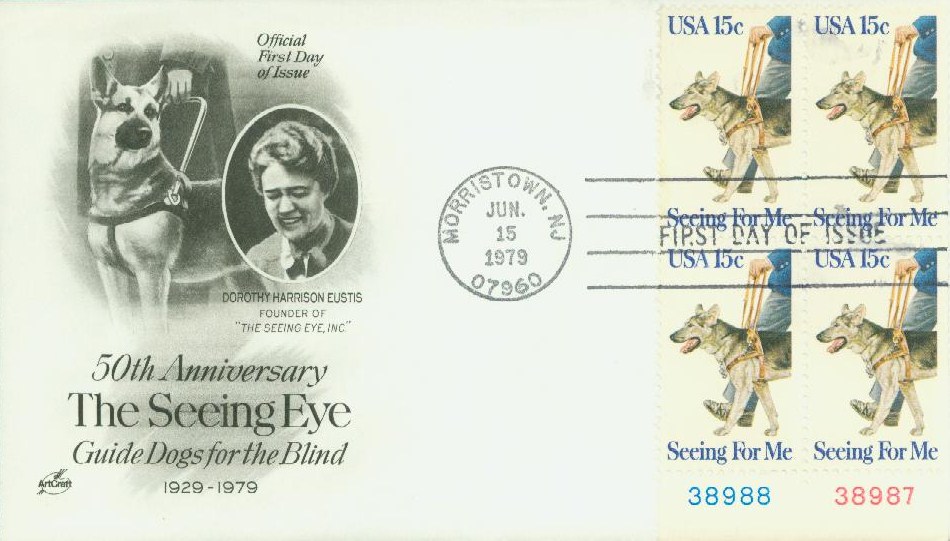
That article earned Eustis significant attention in America, with many people writing her to ask them to train a dog for them. Among those people was Morris Frank, a 19-year-old from Nashville, Tennessee who had been blinded in two different accidents. Frank sent Eustis a letter that caught her attention. He said he hoped to get his own seeing eye dog to help spread awareness so he could later open a school to train guide dogs in the US. While she didn’t train guide dogs, Eustis was moved by Frank’s letter and wanted to help.
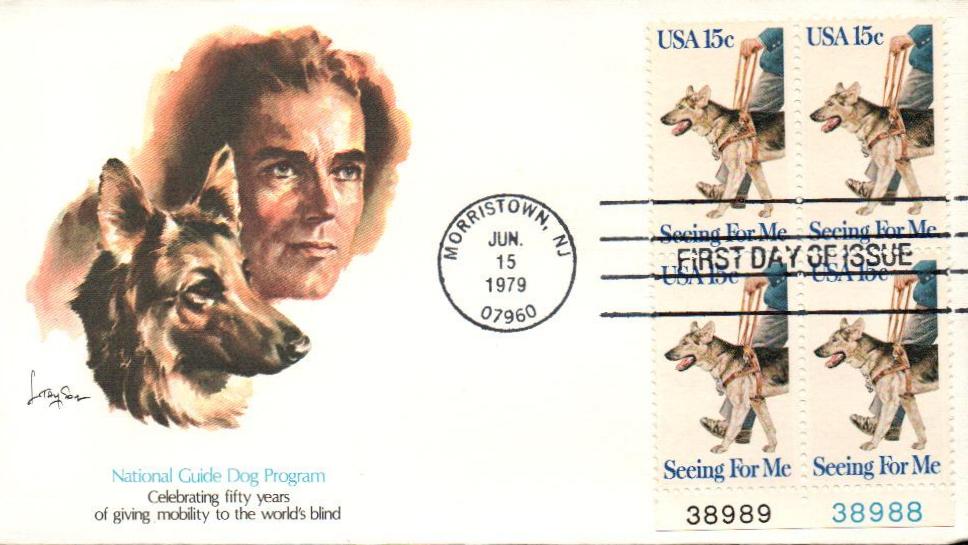
Eustis and Humphrey then began researching how to adapt their training to be utilized by the blind. By April 1928, they had a dog trained for Frank, a female dog he named Buddy. Together, they went through six weeks of training that helped them to bond and learn how to work together to travel busy streets, crowded stores, stairs, and anything else that might come up in Frank’s life. The following year, Frank established The Seeing Eye in Nashville on January 29, 1929. The first class was held the following month.
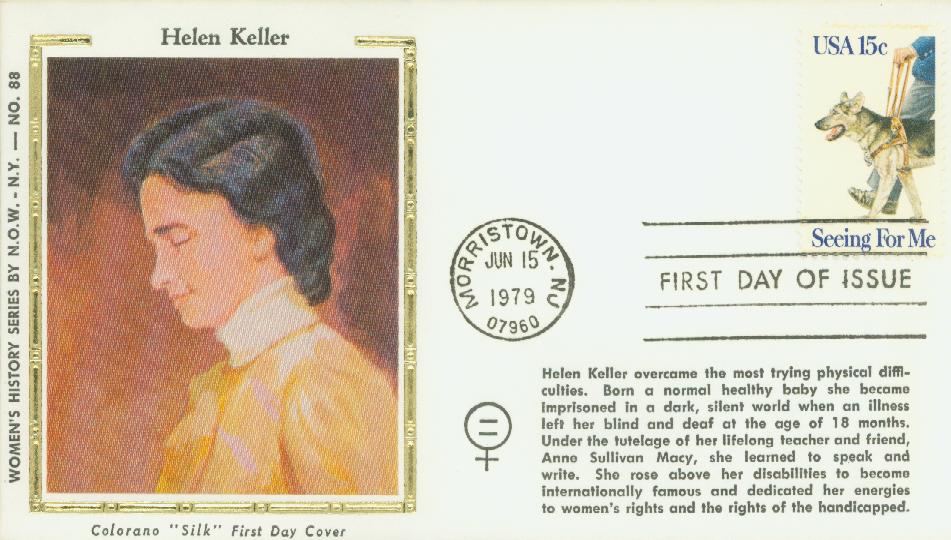
Initially, Frank faced some opposition, as many people were unsure how effective or safe it would be to have dogs leading people through public places. The Seeing Eye also didn’t have funding and would need to hire trainers and find dogs. So Frank and Buddy embarked on a cross-country trip to campaign for the cause. They succeeded in gaining support and understanding, and soon people began to accept the idea. Frank’s efforts were also influential in the passage of the Americans with Disabilities Act, which would give people with service dogs full access to public places.

Eventually, The Seeing Eye moved to New Jersey because of the high temperatures in Nashville. Today, the school operates on a 60-acre facility in Morris Township. Since its founding in 1929, The Seeing Eye has partnered more than 16,000 dogs with blind or visually impaired people in the US and Canada. Today it’s recognized as the first guide dog school in America and the oldest operating such school in the world.
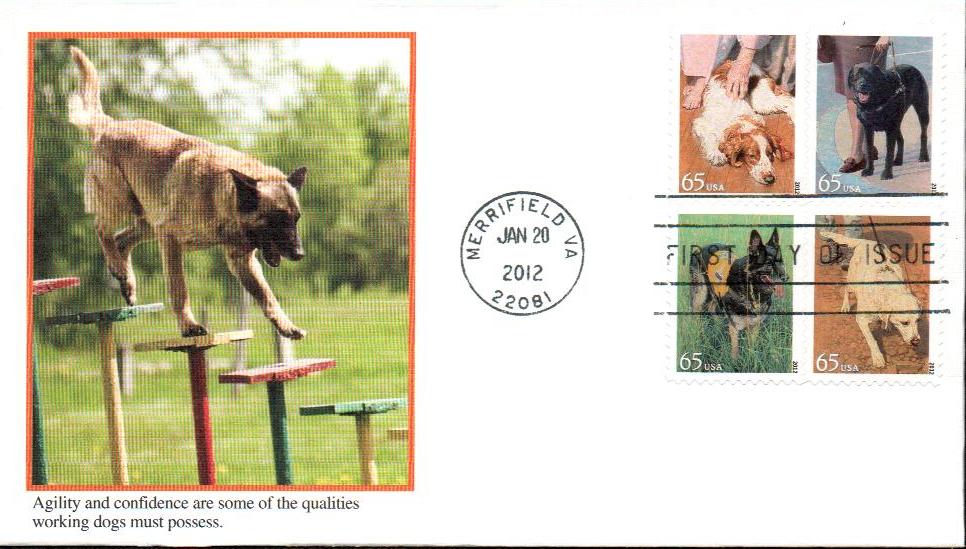
Click here for more about The Seeing Eye on their website.
U.S. #4604-07
2012 65¢ Dogs at Work
Strip of 4
Issue Date: January 20, 2012
City: Merrifield, VA
Quantity: 80,000,000
Printed By: Avery Dennison
Printing Method: Photogravure
Perforations: Die Cut 10 ¾
Color: Multicolored
A well-trained working dog can often mean independence, comfort, and a second chance at life to those it helps. A combination of intelligence, endurance, and obedience is needed for canines that spend their lives serving humans. Through proper selection and intense training, dogs can be taught to aid people in many ways.
Guide dogs for visually impaired people must be friendly and comfortable with new situations. They memorize the routes to familiar destinations and can lead the way with a simple command. The dogs’ confidence allows them to travel to new places.
When a non-judgemental ear and comforting touch are needed, a therapy dog can fit the bill. Whether in times of disaster or a regularly scheduled visit, an affectionate, patient dog reduces anxiety and offers emotional support.
Using their keen sense of smell, security dogs track down criminals or hidden substances. At border crossings and stadiums, canines save time and money with their quick screening ability.
Speed is essential when someone is lost. A search and rescue dog must have agility to move over unstable surfaces to find a victim promptly.
Humans can count on dogs to be faithful guides, companions, or protectors.
The Seeing Eye
The seeing eye dog movement began in Europe in the 1920s. At that time, American Dorothy Harrison Eustis was living in Switzerland and set up a breeding and training facility for German shepherds. Working with a trainer and geneticist Elliot S. Jack Humphrey, she used a scientific method to train police dogs to be intelligent and responsible.
After World War I, many German soldiers returned home blinded or visually impaired. This led to the creation of experimental schools that taught dogs helpful skills. Eustis was impressed by these schools and wrote an article about them called “The Seeing Eye” for the November 5, 1927 issue of The Saturday Evening Post.

That article earned Eustis significant attention in America, with many people writing her to ask them to train a dog for them. Among those people was Morris Frank, a 19-year-old from Nashville, Tennessee who had been blinded in two different accidents. Frank sent Eustis a letter that caught her attention. He said he hoped to get his own seeing eye dog to help spread awareness so he could later open a school to train guide dogs in the US. While she didn’t train guide dogs, Eustis was moved by Frank’s letter and wanted to help.

Eustis and Humphrey then began researching how to adapt their training to be utilized by the blind. By April 1928, they had a dog trained for Frank, a female dog he named Buddy. Together, they went through six weeks of training that helped them to bond and learn how to work together to travel busy streets, crowded stores, stairs, and anything else that might come up in Frank’s life. The following year, Frank established The Seeing Eye in Nashville on January 29, 1929. The first class was held the following month.

Initially, Frank faced some opposition, as many people were unsure how effective or safe it would be to have dogs leading people through public places. The Seeing Eye also didn’t have funding and would need to hire trainers and find dogs. So Frank and Buddy embarked on a cross-country trip to campaign for the cause. They succeeded in gaining support and understanding, and soon people began to accept the idea. Frank’s efforts were also influential in the passage of the Americans with Disabilities Act, which would give people with service dogs full access to public places.

Eventually, The Seeing Eye moved to New Jersey because of the high temperatures in Nashville. Today, the school operates on a 60-acre facility in Morris Township. Since its founding in 1929, The Seeing Eye has partnered more than 16,000 dogs with blind or visually impaired people in the US and Canada. Today it’s recognized as the first guide dog school in America and the oldest operating such school in the world.

Click here for more about The Seeing Eye on their website.










